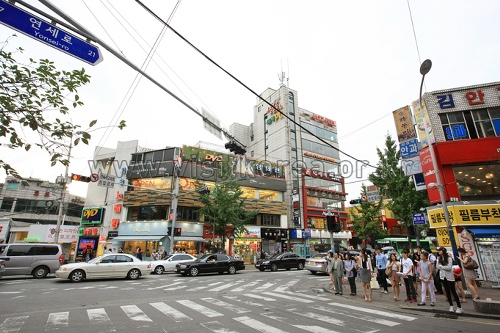K-medi Spring (한강애봄)
3.9Km 2025-10-23
6th Floor, 63 Dongsomun-ro, Seongbuk-gu, Seoul
HanGang AeBom is a certified agency specializing in attracting international patients, offering customized programs that combine Korea’s advanced medical services with tourism. The agency collaborates with medical institutions to arrange consultations, interpretation, accommodation, and travel itineraries.
Lush Korea - Gyeongnidangil Spa Branch [Tax Refund Shop] (㈜러쉬코리아 경리단길 스파)
3.9Km 2024-04-23
2F, 10, Hoenamu-ro 42-gil, Yongsan-gu, Seoul
-
Lush Korea - Gyeongnidangil Branch [Tax Refund Shop] (㈜러쉬코리아 경리단길점)
3.9Km 2024-04-19
1F, 10, Hoenamu-ro 42-gil, Yongsan-gu, Seoul
-
Chuncheonjip Dakgalbi Makguksu (춘천집닭갈비막국수)
3.9Km 2024-03-20
1, Yonsei-ro 5ga-gil, Seodaemun-gu, Seoul
+82-2-325-2361
Located near Shinchon station, Chuncheonjip Dakgalbi Makguksu’s most popular dish is Dakgalbi, which is prepared by marinating boneless chicken in spicy red pepper paste and stir-frying it with various ingredients in a large cast iron pan. Patrons have the option to ppyeo eomneun dakgalbi (spicy stir-fried boneless chicken), cheese dakgalbi (spicy stir-fried chicken and cheese), and maeundakgalbi (spicy stir-fried chicken) as preferred. For an extra tasty treat, one can add an assortment of noodles and vegetables to the chicken as it cooks. After fhinishing the chicken, ordering rice to stir-fry in the pan to soak up the extra flavorful sauce is a must-try.
Yeonsero (Yonsei University Street) (연세로)
3.9Km 2022-10-25
Area of Yeonse-ro, Sedaemun-gu, Seoul
+82-2-120
This road takes you from Sinchon Subway Station right to Yonsei University. Like branching tree roots, the numerous side streets diverge off the main road. In 1999 Yonsei College Street was designated as “The Road One Wants to Walk.” Since then, this famous street has been improved upon even more, placed on tourist maps and promoted by businesses. A visitor to this area can eat at a plethora of restaurants, coffee shops and stores. In the afternoon hours, you can also enjoy the taste of small food stands that line the sidewalks.
PETERPAN 1978 (피터팬1978)
4.0Km 2025-10-29
10 Jeungga-ro, Seodaemun-gu, Seoul
◎ Travel information to meet Hallyu’s charm - "BLACKPINK's Favorite Spots"
Jennie found it on YouTube during her bread tour in Yeonhui-dong. Since opening in 1978, it has been in the same place for over 40 years. There are many delicious breads such as the signature bread “Baby Buttocks” and “Sweet Red Bean Bread 1978,” which has kept the same flavor since 1978. There are many breads that give off a deep flavor when you take a bite, but the “Potato Bread” recommended by JENNIE is particularly savory for its fluffy texture.
Golden Dew - Hyundai Sinchon Branch [Tax Refund Shop] (골든듀 현대신촌)
4.0Km 2024-04-17
2F, 83, Sinchon-ro, Seodaemun-gu, Seoul
-
Kumkang Shoes - Hyundai Sinchon Branch [Tax Refund Shop] (KK현대신촌(금강 금강제화))
4.0Km 2024-04-17
83, Sinchon-ro, Seodaemun-gu, Seoul
-
Bice - Hyundai Sinchon Branch [Tax Refund Shop] (비체 현대 신촌점)
4.0Km 2024-04-18
83, Sinchon-ro, Seodaemun-gu, Seoul
-
Stonehenge - Hyundai Sinchon Branch [Tax Refund Shop] (스톤헨지 현대 신촌점)
4.0Km 2024-04-18
83, Sinchon-ro, Seodaemun-gu, Seoul
-

![Lush Korea - Gyeongnidangil Spa Branch [Tax Refund Shop] (㈜러쉬코리아 경리단길 스파)](http://tong.visitkorea.or.kr/cms/resource/49/2890649_image2_1.jpg)
![Lush Korea - Gyeongnidangil Branch [Tax Refund Shop] (㈜러쉬코리아 경리단길점)](http://tong.visitkorea.or.kr/cms/resource/01/2890701_image2_1.jpg)

![Golden Dew - Hyundai Sinchon Branch [Tax Refund Shop] (골든듀 현대신촌)](http://tong.visitkorea.or.kr/cms/resource/63/2888363_image2_1.jpg)
![Kumkang Shoes - Hyundai Sinchon Branch [Tax Refund Shop] (KK현대신촌(금강 금강제화))](http://tong.visitkorea.or.kr/cms/resource/96/2878296_image2_1.jpg)
![Bice - Hyundai Sinchon Branch [Tax Refund Shop] (비체 현대 신촌점)](http://tong.visitkorea.or.kr/cms/resource/00/2878300_image2_1.jpg)
![Stonehenge - Hyundai Sinchon Branch [Tax Refund Shop] (스톤헨지 현대 신촌점)](http://tong.visitkorea.or.kr/cms/resource/01/2878301_image2_1.jpg)
 English
English
 한국어
한국어 日本語
日本語 中文(简体)
中文(简体) Deutsch
Deutsch Français
Français Español
Español Русский
Русский